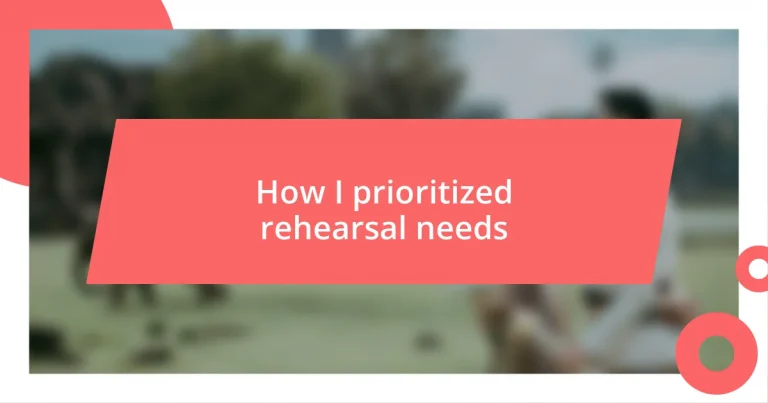Key takeaways:
- Prioritizing group dynamics over technical perfection can significantly enhance overall performance, emphasizing the importance of ensemble connections.
- Establishing clear objectives and regularly assessing them ensures focused, effective rehearsals that align with team goals, while incorporating feedback improves communication and trust.
- Flexibility in rehearsal plans allows for adaptability in the face of challenges, fostering creativity and collaboration among team members during unexpected situations.
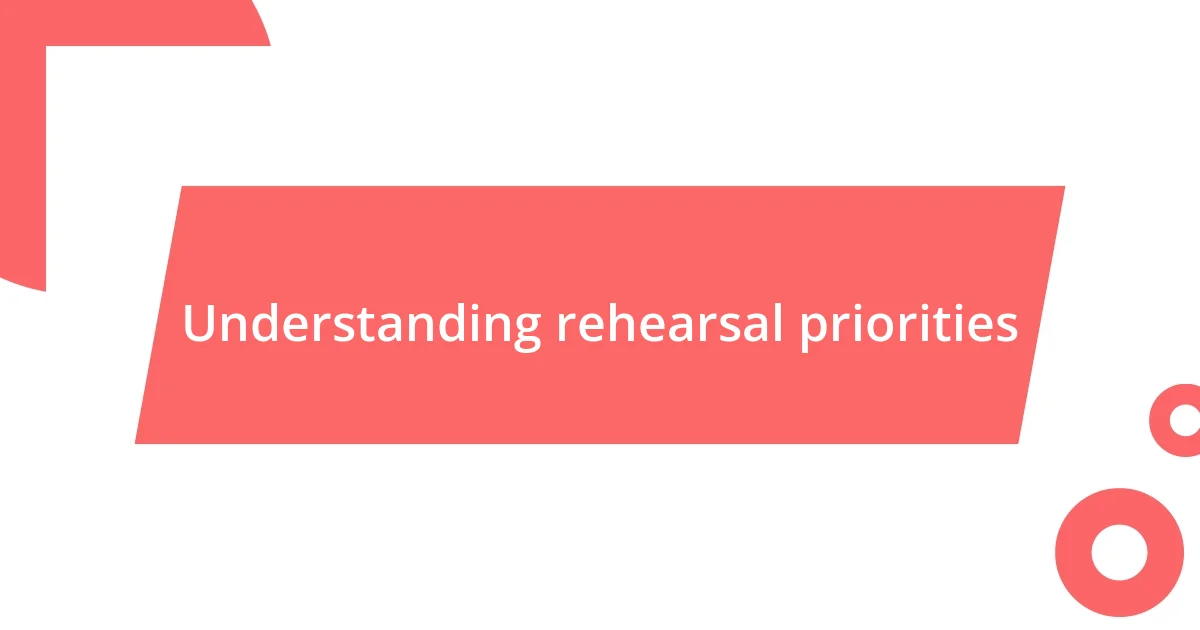
Understanding rehearsal priorities
When it comes to understanding rehearsal priorities, I often think back to my own experiences in preparing for performances. I realized early on that not all aspects of rehearsal hold the same weight. For example, I once spent hours perfecting a single scene, only to discover later that our group dynamic and timing were the real issues needing attention. Isn’t it interesting how we can get so caught up in the details, yet miss the bigger picture?
I’ve found that identifying rehearsal priorities often involves a blend of intuition and experience. There were moments when I had to ask myself: what truly impacts our performance? During one rehearsal, I shifted my focus from memorizing lines to enhancing our ensemble’s connections, and it transformed our entire presentation. In that moment, I understood that prioritizing the group’s chemistry can sometimes outweigh technical perfection.
Reflecting on these priorities, I encourage you to consider what resonates most with your team’s goals. Do you focus more on individual skill development, or is it the synergy of the group that drives success? Balancing these elements requires ongoing reflection and adaptation, but that’s what makes the rehearsal process so enriching.
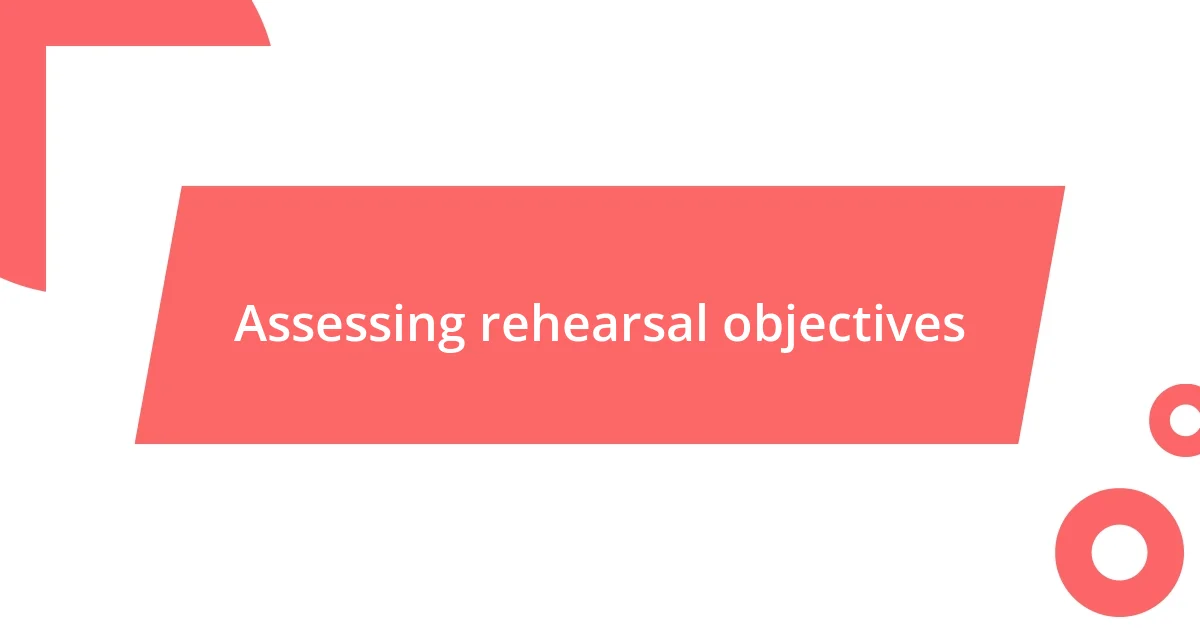
Assessing rehearsal objectives
Assessing rehearsal objectives is crucial for determining what truly needs attention. I recall a time when our group was gearing up for an important performance, but I realized I hadn’t clearly defined what we wanted to achieve in each session. This lack of focus led to scattered efforts and frustration. It was a lightbulb moment for me; establishing specific objectives would help us direct our energies more effectively.
To streamline your rehearsal processes, consider the following objectives to assess:
- Individual Performance Goals: Are there specific skills each member needs to develop?
- Group Dynamics: How well are team members connecting emotionally and artistically?
- Technical Mastery: Are there technical elements, like timing or set transitions, that require more focus?
- Audience Engagement: What do we want the audience to experience during the performance?
- Feedback Mechanism: How will you incorporate feedback from peers or directors to refine objectives?
This structured approach can offer clarity and empower your team to work cohesively while honing in on what matters most.
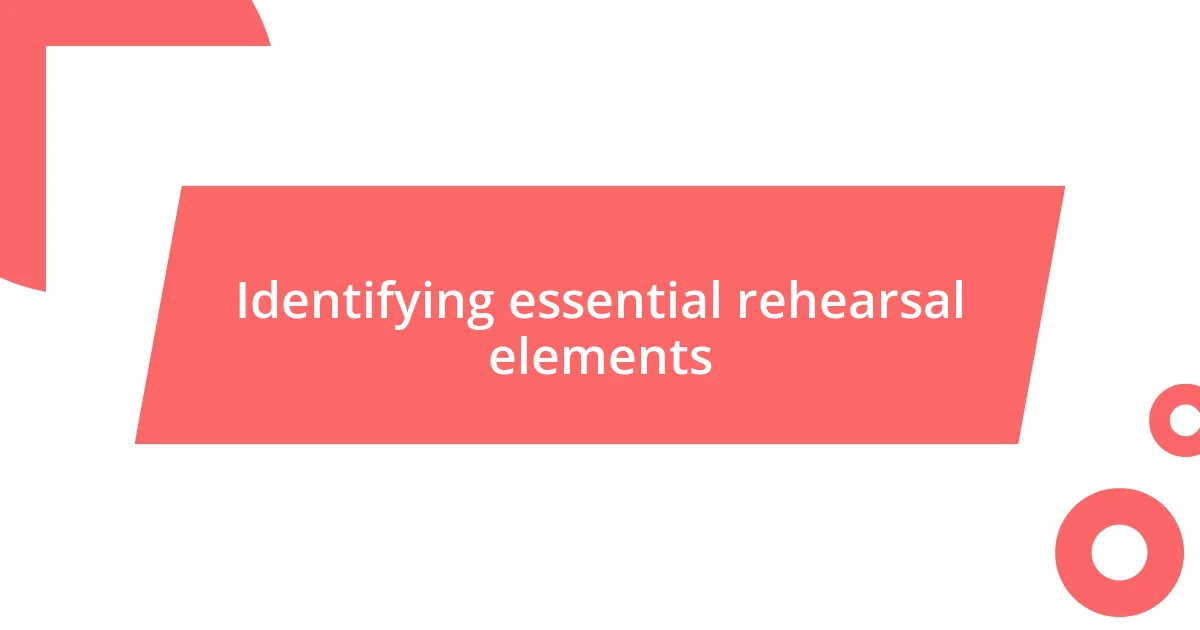
Identifying essential rehearsal elements
Identifying essential rehearsal elements is key to a productive process. From my experience, I’ve seen how different components interact to either propel a performance forward or hold it back. One time, we discovered that our choice of rehearsal space significantly impacted our energy levels. A cramped, distracting environment made it difficult to focus. It taught me that the right setting can enhance creativity and collaboration among the team.
Another crucial element to consider is the selection of repertoire. I remember when we chose a piece that resonated with every member. The excitement and personal connection made the rehearsals feel less like work and more like a journey together. The emotional investment we all brought to the table was palpable, making it clear that picking material that ignites passion can enhance group cohesion and drive.
Lastly, the incorporation of feedback cycles in rehearsals cannot be overlooked. I’ve found that regularly checking in with team members about their perspectives fosters an open dialogue. I once initiated brief feedback sessions after each run-through, which allowed us to address concerns immediately. This simple shift not only improved our performance but also deepened trust and communication among us. These essential elements combined create a comprehensive rehearsal landscape that truly elevates the final product.
| Essential Element | Description |
|---|---|
| Rehearsal Space | Environment affecting focus and energy. |
| Repertoire Selection | Choosing material that resonates with the team. |
| Feedback Mechanism | Regular check-ins to enhance communication and performance. |
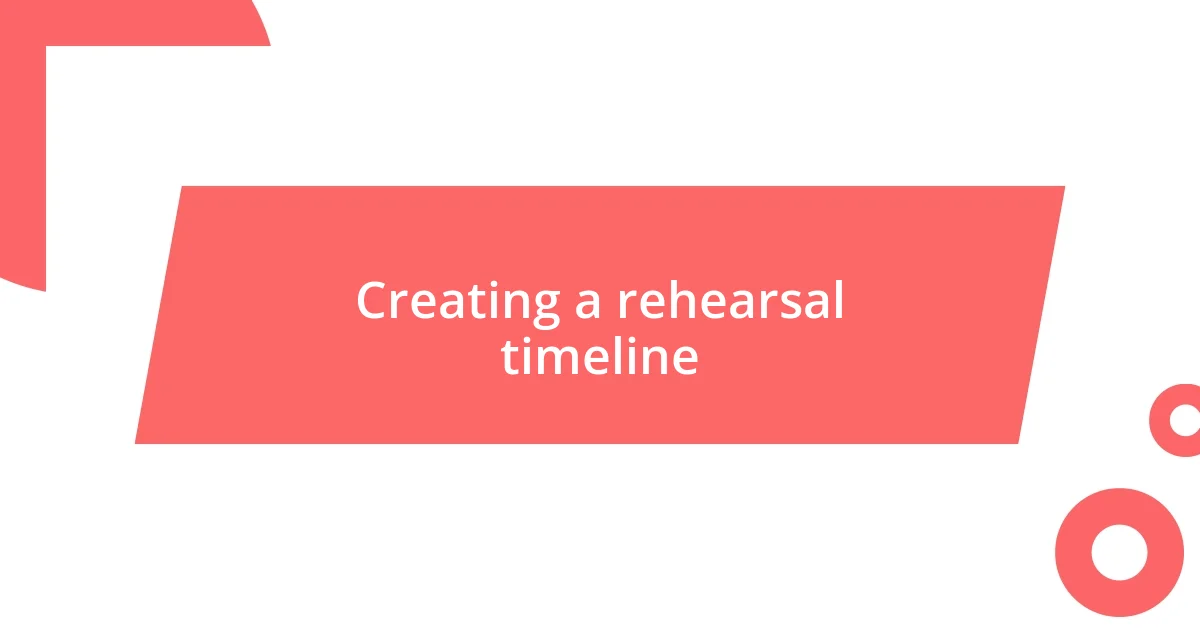
Creating a rehearsal timeline
Creating a rehearsal timeline is one of the most rewarding aspects of preparing for a performance. I remember the first time I laid out a timeline for our rehearsals; it was like finally putting a puzzle together. By establishing clear dates and benchmarks, I could visualize our progress and ensure we were on track. Has it made a difference? Absolutely! It transformed chaotic practices into focused sessions that felt purposeful.
As I mapped out our rehearsal timeline, I learned that being flexible is just as critical as having a plan. There were moments when unexpected challenges arose, such as a key member falling ill or a technical issue cropping up. Instead of panicking, I adjusted the timeline, recognizing that adaptability is crucial. This experience taught me the value of including buffer time—moments to breathe, reflect, and recalibrate. How often do we forget to factor in those essential pauses?
I also discovered that sharing the timeline with the entire team brought us closer together. When everyone is aware of deadlines and objectives, it creates a sense of collective ownership. I vividly recall one rehearsal where we celebrated crossing off a major milestone together; the energy in the room was infectious. That moment reinforced my belief that a well-structured timeline does more than guide rehearsal; it fosters camaraderie and commitment among the team.

Allocating resources for rehearsals
Allocating resources for rehearsals can sometimes feel like a balancing act. I remember when our theater group needed additional lighting equipment for a special production. At first, it seemed daunting, but I reached out to a local rental company. Their willingness to lend us what we needed not only filled the gap but also nurtured a supportive community. It’s amazing how resource allocation fosters those connections that can be crucial for future projects.
Another important aspect I learned is the necessity of time management. I once found myself overcommitting space and hours without considering the team’s schedule. The realization hit me hard when some actors couldn’t make it, and we lost valuable rehearsal time. Now, I always assess our collective availability beforehand, making sure that everyone’s input and time are respected. Have you ever wondered how group dynamics change when everyone feels included and valued? Trust me, it makes a world of difference.
Budget considerations are also essential. I vividly recall a time when we had to choose between quality props and additional rehearsal time. After weighing my options, I opted for the props, thinking they’d elevate our performance. Looking back, I realized I should have prioritized time over material. A lesson learned! Effective resource allocation isn’t just about distributing what you have; it’s about maximizing what’s most important for the overall success.
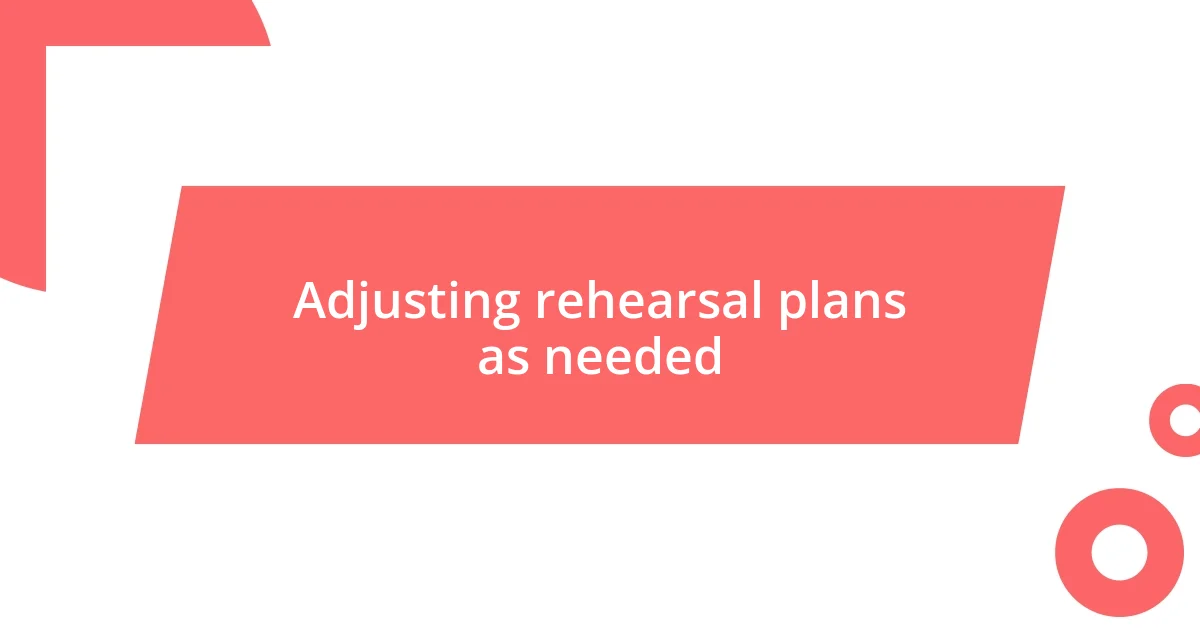
Adjusting rehearsal plans as needed
Adjusting rehearsal plans on the fly has become one of my most essential skills. There was a time during our tech week that we lost an entire day due to a last-minute venue change. Instead of getting frustrated, I chose to reassess our priorities and condensed the next few rehearsals. This pivot not only kept us on track but also created a sense of urgency that surprisingly motivated everyone.
One of the most poignant moments for me was when a lead actor faced an unexpected personal issue. Rather than pushing through, I took a step back and facilitated a discussion within the team. Have you ever noticed how open communication can foster resilience? We collectively decided to redistribute scenes among ourselves, which not only eased the pressure but also highlighted hidden talents within the group. It reminded me that flexibility often leads to creative solutions that we never saw coming.
On another occasion, I had meticulously planned a rehearsal for choreography, only to discover, moments before, that the dancers were feeling fatigued. Instinctively, I scrapped the original agenda for a lighter, more engaging session filled with improvisation. The fresh energy that flowed through the room was electric. I realized then that adjusting plans isn’t a sign of failure; it’s an opportunity to connect, refresh, and sometimes, even uncover something magical within the process.
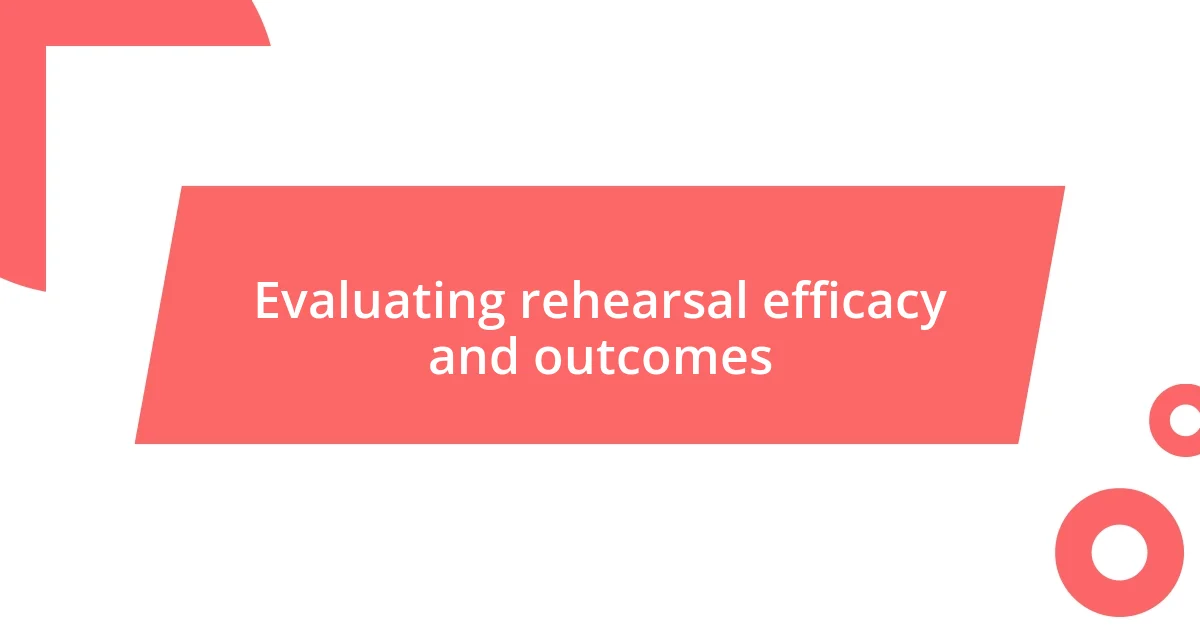
Evaluating rehearsal efficacy and outcomes
Evaluating how effective our rehearsals are has always been a bit of a challenge for me. I vividly remember a situation where we spent countless hours working on a complex scene, but when performance day came, the connection just wasn’t there. It made me question: How do we measure success in rehearsal? Are we focusing on the right elements, or are we simply going through the motions? It took that experience for me to understand that true efficacy lies in the quality of engagement rather than just the quantity of time put in.
I often find myself reflecting on outcomes post-rehearsal. After one particularly rigorous rehearsal, I gathered everyone for a quick debrief. It was enlightening to hear different perspectives, where even the quietest members felt empowered to voice their thoughts. This practice not only highlighted areas for improvement but also reinforced the importance of creating an inclusive environment. Have you ever had a moment when you realized that feedback could foster growth even during the most difficult processes? This revelation reshaped my approach to rehearsals, making them a collaborative learning experience rather than just a checklist of tasks.
Not all rehearsals turn out as planned, and that’s ok. One time, after a rehearsal that felt disjointed, I decided to gather everyone for some constructive feedback. The feelings in the room shifted as team members shared their frustrations and triumphs in a safe space. It dawned on me that assessing rehearsal outcomes isn’t just about the performance metrics; it’s about understanding team dynamics and emotional responses. I now believe that the true measure of rehearsal efficacy comes from the collective journey we embark on together. What do you think? Have you seen that kind of transformation in your own experiences?












